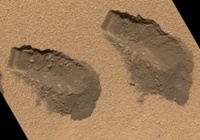Mars comprises 2% water, latest Curiosity findings show
30 Sep 2013
Was there ever life on Mars? The first analysis of soil dug up by NASA's Curiosity rover has given new insights into the red planet's propensity for retaining water beneath its surface.
 |
| The Sample Analysis at Mars instrument suite, prior to its installation on the Curiosity rover. Image Credit: NASA Goddard |
After examining fine-grained soil particles extracted by the Curiosity rover from beneath the surface of Mars, scientists have concluded that roughly 2 per cent of the Martian surface soil is made up of water in terms of weight. They have also found other evidence that hint at liquid water having once existed on the planet.
There is no indication of organic material besides Earth-transported microbes; but findings are positive for future manned missions to Mars, wherein astronauts could mine the soil for water and advance scientists' understanding of Martian history.
Given the renewed interest of late in manned missions to Mars - from non-profit organisations like Mars One, private transportation companies like SpaceX, and unofficial plans at NASA, these findings are reassuring.
 |
| The Sample Analysis at Mars instrument suite found water in the dust, dirt and fine soil from the Rocknest site on Mars. (This file photo shows trenches Curiosity dug in October 2012.) Image Credit: NASA/JPL-Caltech/MSSS |
The results were announced in a special edition of the journal Science this week, with five papers on the rover's analyses, led by a review article from John P Grotzinger, project scientist at the NASA Mars Science Laboratory (MSL) mission.
Soil samples were picked up from a patch of sand, silt and dust called Rocknest. They were heated to 835 degrees Celsius and studied by instruments on board the rover.
''The major gases released were water – about 2 per cent by weight of the sample – and carbon dioxide, oxygen and sulphur dioxide,'' said Dr Laurie Leshin of MSL, who was the lead author of the paper published by her team.
Analysis by the rover's instruments found that there were about two pints of water locked up in every cubic foot of Martian dirt. ''That's a real resource for future explorers. We can access it with just a little bit of heating,'' Leshin quipped.
Her team also found carbonates, which are formed in the presence of water, and aluminosilicates, ferric compounds, and sulphates.
The tool Curiosity used to analyse the sample was a collection of instruments called Sample Analysis at Mars, or SAM, that contains a gas chromatograph, a mass spectrometer, and a tuneable laser spectrometer.
The rover first scooped up dirt, dust, and finely grained soil from a 2.5-inch-deep hole it dug in Rocknest in February. Then a tiny, pill-size portion of the sample was fed into SAM, where it was heated to 1,535 degrees Fahrenheit.
 |
| Mosaic image of Curiosity. Image Credit: NASA/JPL-Caltech/Malin Space Science Systems |
The gases that were released were analyzed, and apart from significant portions of carbon dioxide, oxygen, and sulphur compounds, gaseous carbonite was found in a quantity that suggests the presence of water in Martian soil.
Leshin notes that oxygen could have come from the breakdown of a perchlorate mineral. Perchlorates are a sensitive marker of past climate and could have participated in the transformation of Martian organic matter.
Because of similarities between the compounds in the soil and the atmosphere, the 'dirt' collected by the rover seems to have acted as a sponge for the atmosphere, which is where the volatile materials could be derived from.
''We can see that especially in the amount of the different types, or isotopes, of hydrogen. We know that the atmosphere contains extra heavy hydrogen, called deuterium. And we see that same thing in the water bound in the soil,'' said Leshin.
These findings will be used to fine-tune future experiments on drilled rocks on the red planet, which are thought to better preserve signs of life that were absent in the Rocknest sample.






























